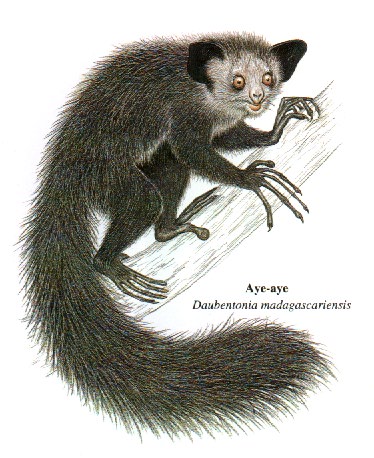The aye aye seems to me like a crossing between a squirrel, a bat, a monkey and a really sloppy day of creation by God (no offense!). Poor thing. Even though their looks aren't that pleasing, they're pretty cool animals!
Believe it or not, these mammals are related to apes, chimpanzees and humans! They're originally from Madagascar - a place where almost everything dubious and fascinating in terms of animals can be born, from all that I've seen during college - and live in nests in treetops of rain forests, avoiding coming down to earth. Nocturnal animals, they are the only primates thought to use echolocation to find prey (like bats, told ya!), which is totally amazing! The aye-aye taps on trees with its long middle finger and listens for wood-boring insect larvae moving under the bark. It employs the same middle finger to fish them out. The digit is also useful for scooping the flesh out of coconuts and other fruits that supplement the animal's insect (and omnivore) diet.
They can live up to 20 years in captivity and are considered a threatened species, and are protected by law. They have been hunted a lot in the island, since many natives believe that they're an omen of ill luck. It's so sad to know that a unique species like this still suffers from human ignorance. But, thinking again, which non-human species doesn't?
Believe it or not, these mammals are related to apes, chimpanzees and humans! They're originally from Madagascar - a place where almost everything dubious and fascinating in terms of animals can be born, from all that I've seen during college - and live in nests in treetops of rain forests, avoiding coming down to earth. Nocturnal animals, they are the only primates thought to use echolocation to find prey (like bats, told ya!), which is totally amazing! The aye-aye taps on trees with its long middle finger and listens for wood-boring insect larvae moving under the bark. It employs the same middle finger to fish them out. The digit is also useful for scooping the flesh out of coconuts and other fruits that supplement the animal's insect (and omnivore) diet.
They can live up to 20 years in captivity and are considered a threatened species, and are protected by law. They have been hunted a lot in the island, since many natives believe that they're an omen of ill luck. It's so sad to know that a unique species like this still suffers from human ignorance. But, thinking again, which non-human species doesn't?
~Ally

 RSS Feed
RSS Feed